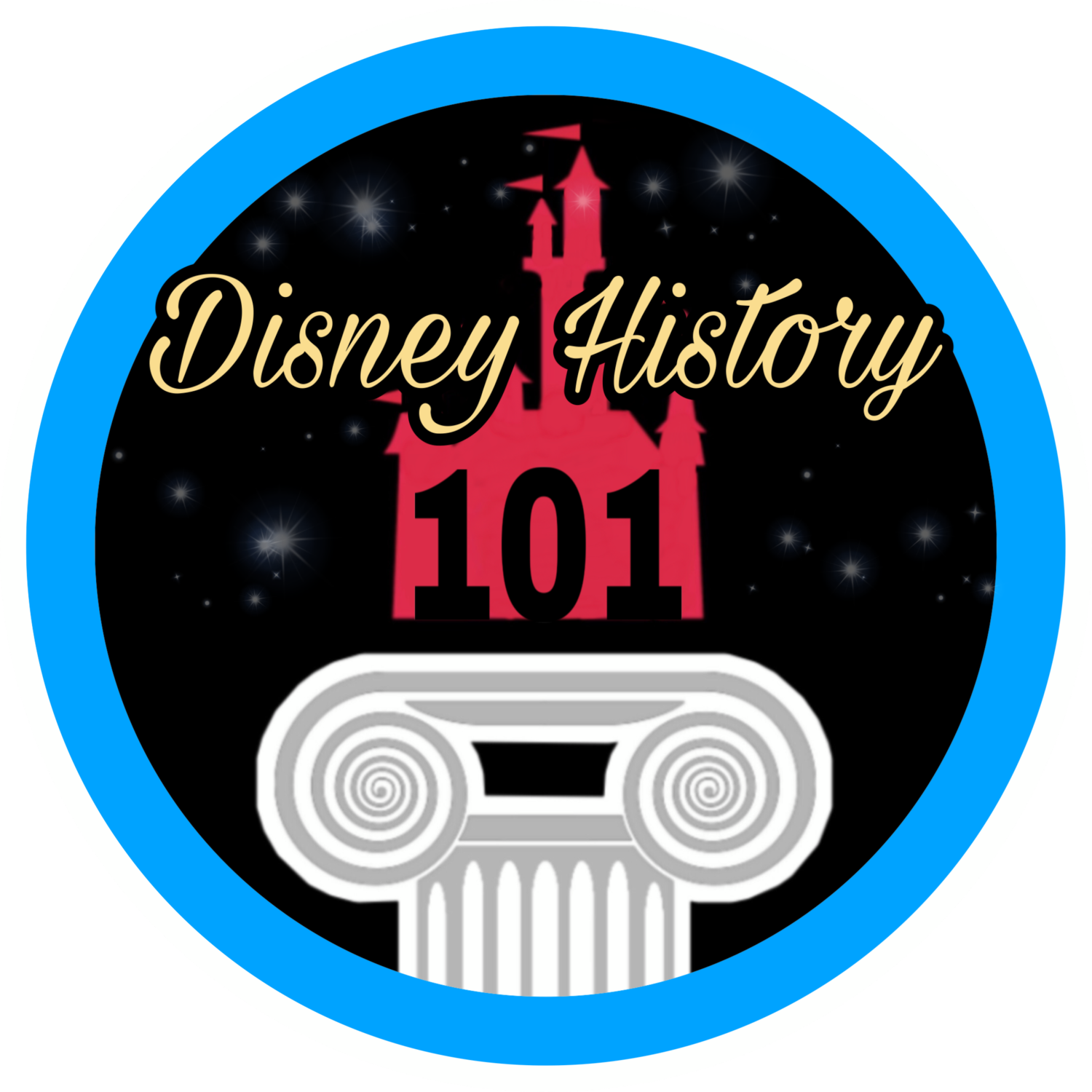FLYING SAUCERS

(August 6th, 1961 - August 5th, 1966*)
*(“Disneyland Rides & Attractions and Attendance Report,” 1981)
One can easily slip into the jargon of “ride,” but at Disneyland there is a "story behind the story" of every attraction, every attraction is a living experience for the guest. Disneyland ride-through attractions or adventures have officially been defined as an “individual show, ride, or exhibit designed to produce an entertaining Guest experience. Disney attractions stir the imagination, enliven the senses, and provide the participants with positive, innovative entertainment, which is the essence of the DISNEYLAND Show.” It is important to review the story of the attraction, tell the story, explain it, and create interest. This is the story of Flying Saucers.
The presentation of the Flying Saucers show on the vast DISNEYLAND “stage” was to be a distinct part of the Disneyland theater concept. “Please step this way,” as we explore the story of how other-worldly Flying Saucers descended upon Tomorrowland for half-a-decade.

“Draw Concept” - Duck Bumps by Bruce Bushman, (c. 1954) ; Former Collection of Richard Kraft
“Blue Sky for a Bumper Ride”
The idea of a “bumper ride” had been around since Disneyland’s design and development phase. Why, back in 1954, Bruce Bushman created concept art for “Duck Bumps”, a water-based Donald Duck-themed Fantasyland attraction (that would have possibly been situated somewhere near the “Pink Elephants” and the “Mad Tea Party” attractions). The vehicles would have been distinctly unlike most at Disneyland - individually-controlled by Guests. Soon, Popular Mechanics (December of 1954) even made mention of “Donald Duck boats” among the landmarks of the Disneyland project.
Meanwhile, Herb Ryman created the iconic “Aerial Over Disneyland” concept drawing! A contemporaneous document called “The Disneyland Story” was produced (on September 3, 1954), in order to tell the story of what guests would experience upon entering Disneyland and Tomorrowland. After a detailed 2-page description of the Rocket to the Moon attraction, the document plainly states : “We will have other outer space rides that we will develop as the Park progresses.” Further, Walt Disney himself, on the eve of Disneyland’s first day of operation, promised that “Disneyland will never be completed. It will continue to grow, to add new things, as long as there is imagination left in the world.” Disneyland opened, and though “Duck Bumps” never materialized, Tomorrowland debuted with one major space adventure - TWA’s Rocket to the Moon and its Rocket Pylon!
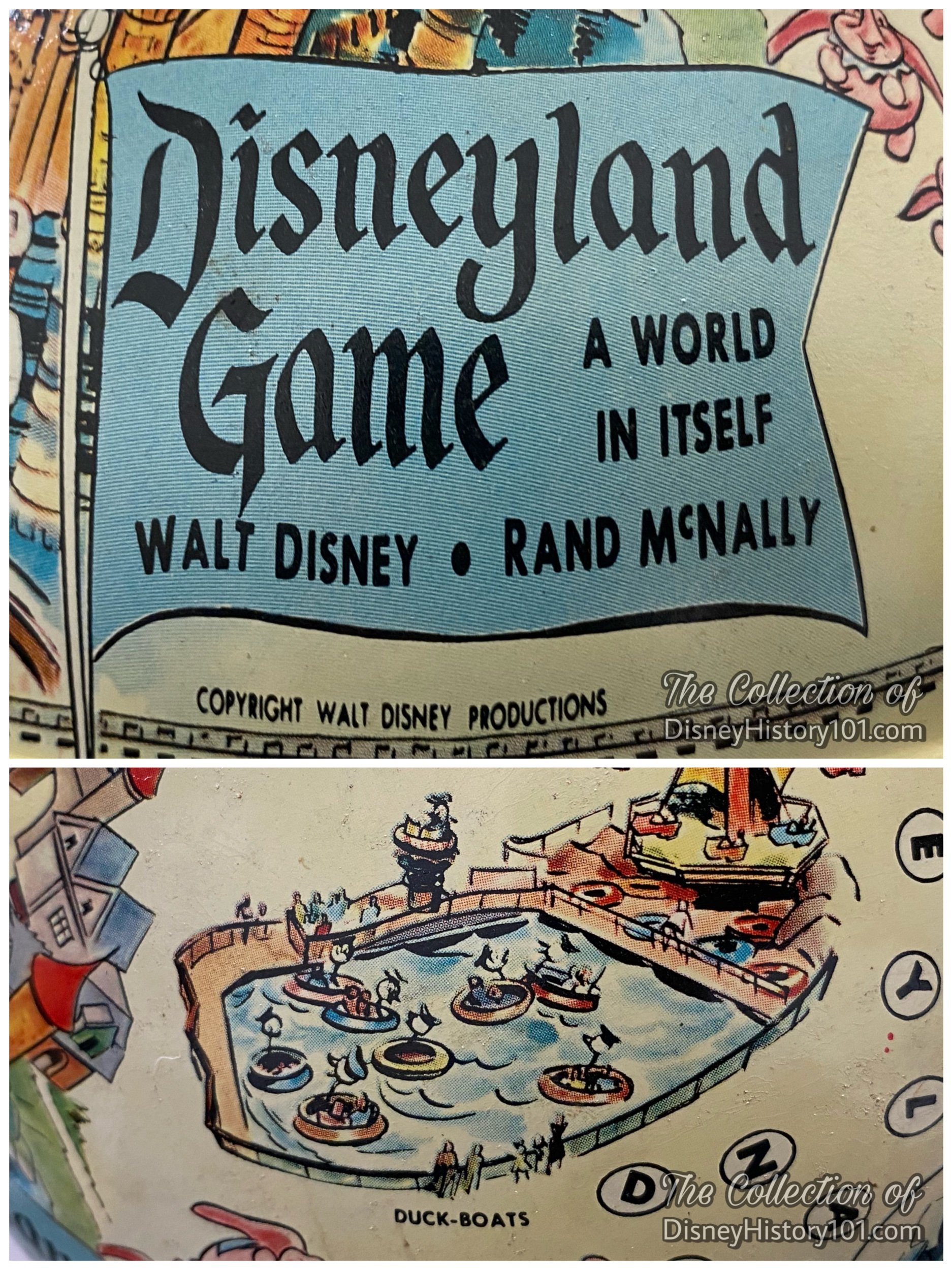
The “Duck-Boats” appeared on the Disneyland Game by Rand McNally.
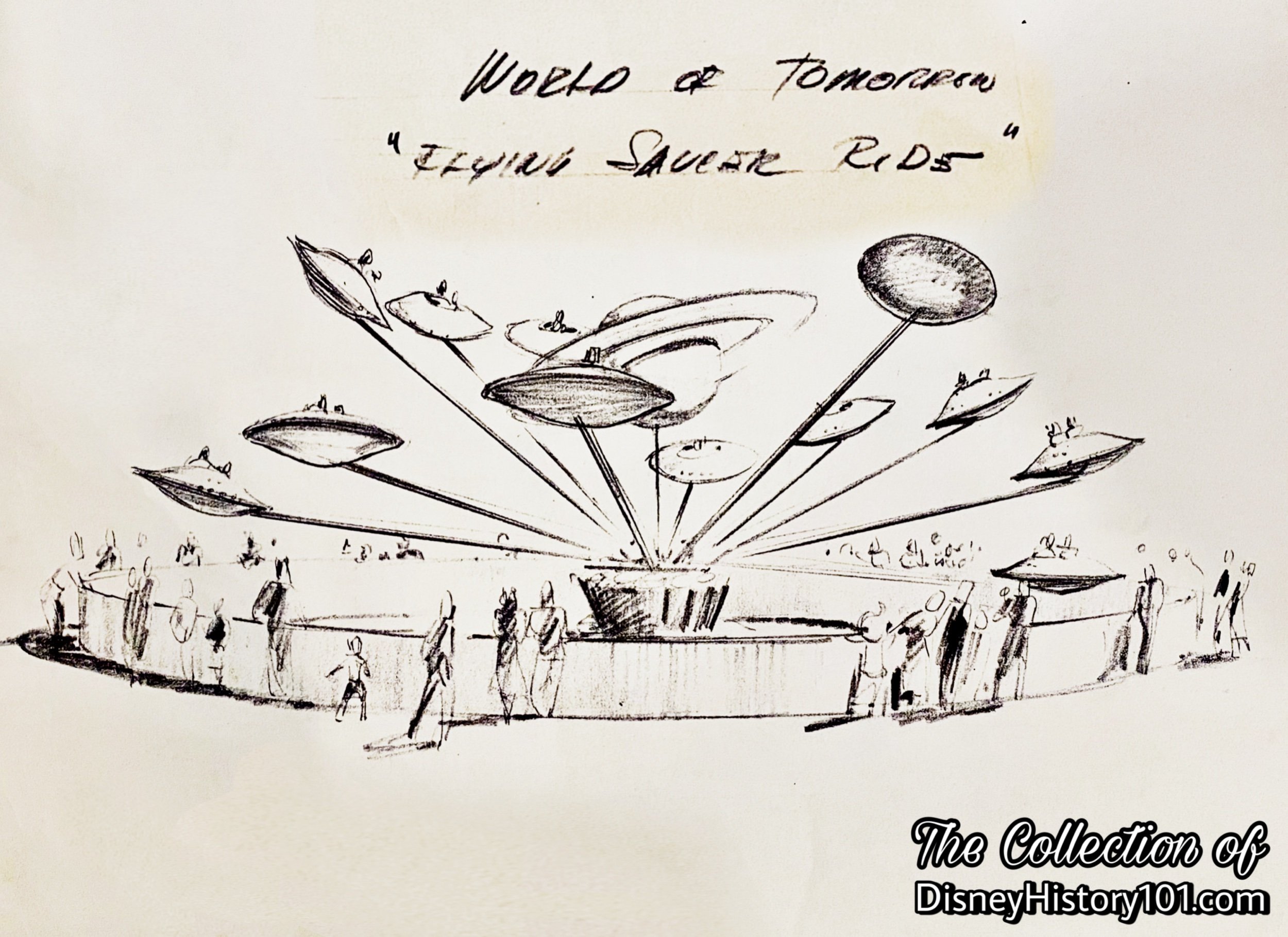
A Bradley & Kaye artist produced this World of Tomorrow Flying Saucer Ride concept for Disneyland, Inc.

Bradley & Kaye's concepts for the Rocket and Flying Saucers rides as they appeared in “The Disneyland Story,” a souvenir printed 1955.
Tomorrowland soon came to house many other outer space-themed adventures - from the AstroJets to Space Station X-1 - and (as Walt promised) another truly “out of this world” adventure was to descend upon Disneyland!

“Future Duck Bumps” were referenced by Bruce Bushman in his concept for a “Mousekeville” Area planned for development between Fantasyland and Tomorrowland; produced between December 8-15, 1956.
Remember that Walt Disney had earlier said : “Disneyland will never be completed. It will continue to grow, always adding new things to provide its visitors with exceptional and entertaining attractions.” In Walt’s eyes, Disneyland was “like a piece of clay,” because if there was something he didn’t like, he wasn’t stuck with it. He could reshape and revamp it. After years of personally reshaping and revamping, Walt divulged: “I’m not the perfectionist anymore. It’s my staff - they’re the ones always insisting on doing something better and better.”

Development on “Duck Bumps” continued until sometime in 1956, when the attraction was either abandoned or “voided”.
Nets overhead may have been intended to keep out any unwanted waterfowl.

Flying Saucers Ride (Patent 192932) Facsimile
Bob Gurr who (had a hand in the design of many Disneyland vehicles) came up with the “ornamental design” of the Flying Saucers (pictured in the patent figure facsimile above). He remembered : “In those days, everybody had a hovercraft project. It was a neat idea…a ‘big buzz’ at the time, and a lot of people were working on some form of hovercraft project simultaneously….Arrow’s concept of moving the motive force out of the vehicles to underneath the floor was a novel idea…I was now recognized by the United States government as a ‘Flying Saucer Inventor’, a title which placed me in good company with all the other flying saucer crack pots of the time.” Other artists like Wilson “Bill” Martin (who had left 20th Century Fox, to work on Walt Disney Productions’ Disneyland project in 1954) made contributions to the design of the project, Bill’s former talents as art director applied to the attraction.

An Arrow Development Co. business card.
“The Science of ‘Science Fiction’ - Engineering The Flying Saucer”
These four fleets (of 16) alien vehicles were not unidentified, but (in fact) on the “creative menu” and manufactured by a very terrestrial (earthly) company called Arrow Development (of Mountain View, California) and National Research Associates Inc. Utilizing Arrow for the project was practical, as Arrow Development had (from 1953 to 1955) both researched and developed many of the ride systems, tracks, and vehicles for many of Disneyland’s Opening Day attractions. This Ed Morgan and Karl Bacon (founders of Arrow Development) accomplished through their own streamlined engineering process. Utilizing Arrow Development was also convenient, as Walt Disney Productions had purchased 1/3 of Arrow Development in 1960. As for National Research Associates Inc., they had been in the business of developing air-cushion systems for the United States Army and the Marines. Now, technology that was good enough for military applications, would (by Ed and Karl) be applied to Walt’s next addition to his vision of Tomorrow!

Note the Fan Buildings (providing the cushion of air) located to the left and right of the Flying Saucers on this Plot Plan of Tomorrowland.
Now, the saucers would not truly fly, but operated in an arena that was not too different from an air-hockey table. Disneyland Vice President Joseph W. Fowler revealed (in “Disneyland News”, Vol.1, No.1, 1961) that “‘Disneyland has been experimenting with the Flying Saucers in Northern California for some months. Because of the air-cushion principle involved, we have kept the tests completely under wraps. However at this time we can reveal that each saucer will be a self-contained unit in which one guest pilots his own ships in free flight.” According to Roger Broggie : “We had figured that we could move a two-thousand pound payload if we had an air jet below with valves that allow air to come up through holes in the floor.” The Flying Saucers were capable of “catching some air” - when the weight was perfectly centered, air beneath the saucers was capable of blowing the vehicles up to 8 inches off the ground! Otherwise, guests controlled the vehicle utilizing the round handles, and tilting their body in the direction they wanted to travel.
Notable scientist Willy Ley (who was once a technical consultant for Tomorrowland) once commented: “I consider it possible that we can get visitors from space, but I do not think flying saucers are it.” Despite Dr. Ley’s scorn of the though of flying saucers, some six years after Disneyland opened, official Press Releases heralded : “Flying Saucers are reported heading toward Disneyland. No figment of the imagination, flying saucers are destined for the Park, to become one of Walt Disney’s latest attractions for the 1961 season”, according to Vacationland (Summer, 1961). Those who would recollect seeing Bruce Bushman’s c. 1954 concept drawings of “Duck Bumps” (a Fantasyland attraction which never fully materialized), would realize that seven years had transpired since that original concept. It had now been both re-worked and re-themed, and a form of the original attraction idea was finally becaming a reality!

Flying Saucers Construction Barrier from the Skyway, 1961.
“First on Earth - Flying Saucers”
Joe Fowler (Disneyland Operations Committee) oversaw the Construction & Maintenance division including Engineering, New Construction, Maintenance, and Janitorial relating to the Flying Saucers. Soon a yellow and white construction barrier appeared with a sign depicting an "Astrogram" reporting “Flying Saucers… First on Earth.”
Like something out of War of the Worlds, flying saucers were making waves, over the radio when Chief Engineer John Wise gave a talk on local Radio KNX regarding the new Flying Saucer adventure. Promotional media also made mention of flying saucers at Disneyland. For instance, during 1961, “Anaheim... Future Unlimited” was published by the Anaheim Chamber of Commerce. Inside, the words of Marty Sklar (of WED Enterprises) referred to: “Tomorrowland, home of Flying Saucers, America's first monorail train, rocket ships and submarines.”

Disneyland Map by Sam McKim Excerpt, mid-1960s
Yes, Walt Disney’s newest $400,000 attraction (of a $2.5 million expansion) allowed Guests to “fly” one of 64 air-cushioned Flying Saucers by themselves (or together with a friend), over 16,000 square-feet of Tomorrowland-scape! The Flying Saucers at the Disneyland Spaceport were located in a little nook of Tomorrowland (not far from other flight-based adventures)!
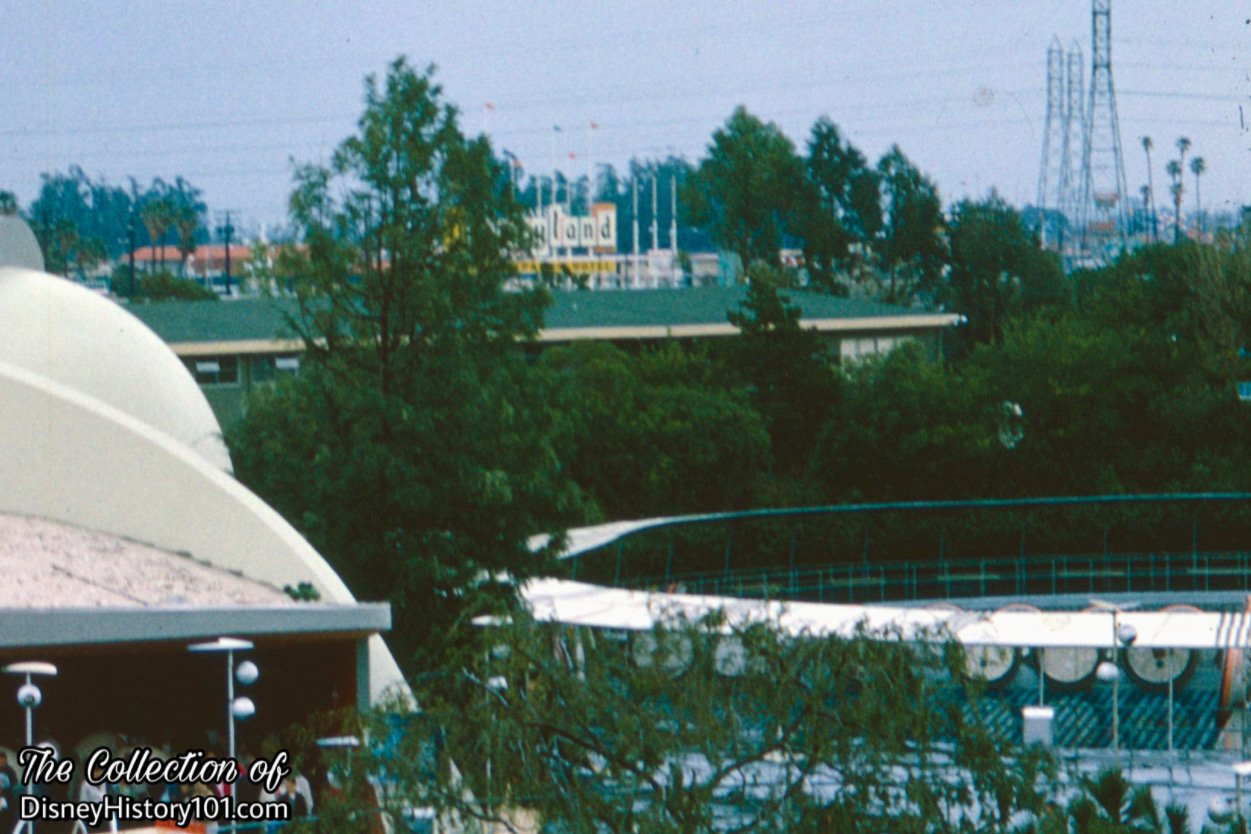
Notice the Flying Saucers (right) cycled-out on a rainy day in 1961.
Unlike other individually-controlled attractions (like the Autopia vehicles or the Motorboats), the Flying Saucers were not tethered to a track or guide rail. Apparently one of the few things that could hinder their flight was water (see above).
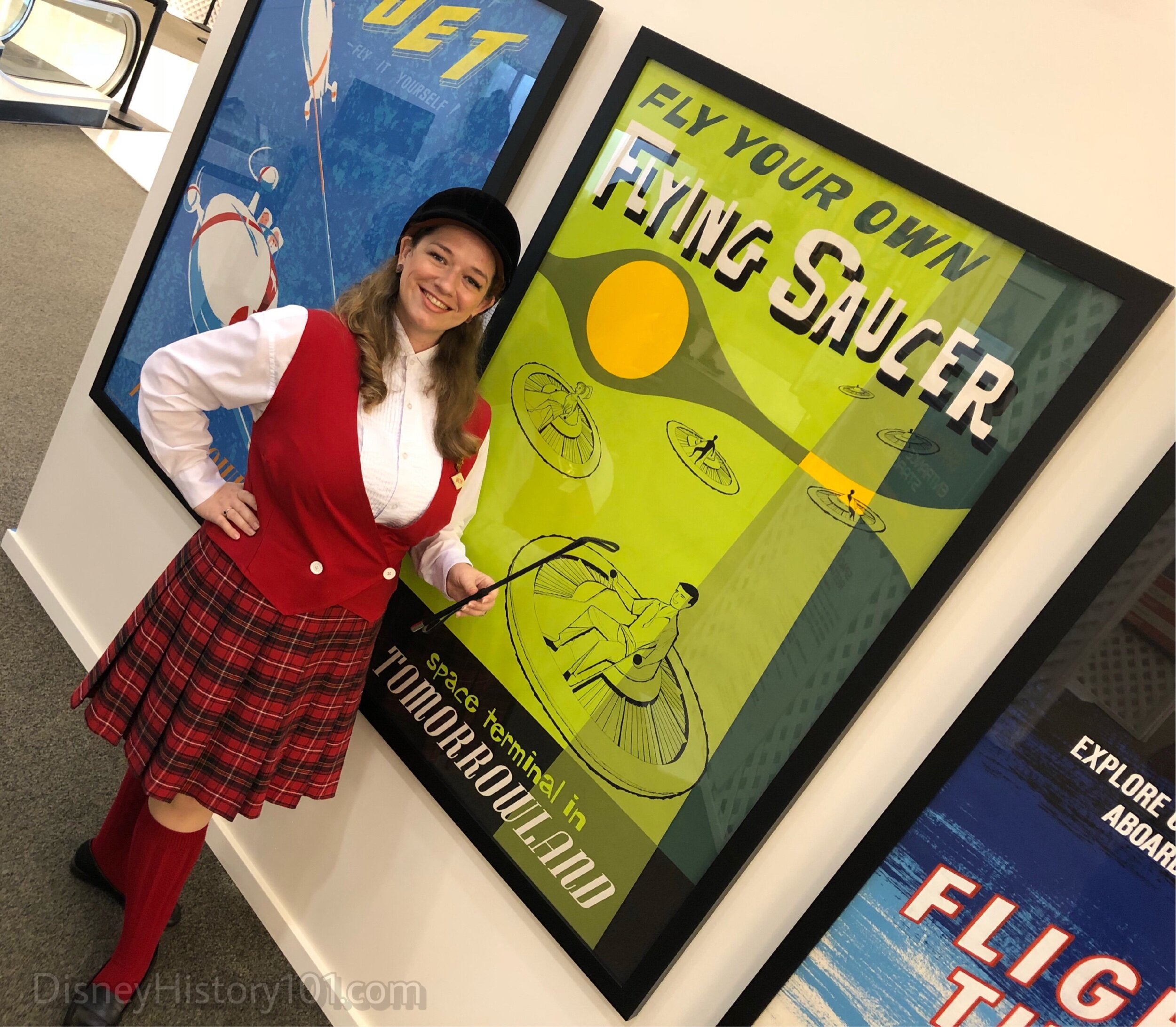
Flying Saucer Attraction Poster by Rolly Crump, c. 1961.
A Flying Saucers attraction poster was designed by Rolland Fargo Crump, who is most famously known for his contributions toward several of Walt Disney Productions’ 1964/1965 New York World’s Fair exhibits and attractions (in addition to some pretty “far out” artwork).

Flying Saucer Attraction Poster by Rolly Crump, c. 1961.

Disneyland ‘61 Banner announces Fly Saucers on Main Street, U.S.A.
High over Main Street, “Disneyland ‘61” Banners advertised Tomorrowland’s newest “extra-terrestrial” additions, including the Disneyland-ALWEG Monorail System and the Flying Saucers!

A press release photo captures the balloons over the Flying Saucers; ©️ Walt Disney Productions.
In August of 1962, Lloyd Richardson, Larry Clemmons, Joe Marquette, and Jack Leppert (of the Walt Disney Studio) filmed and shot scenery of the Flying Saucers for Studio Production #3185. “Balloons” and “beach balls filled with air” were requested. It was also requested that “all saucers…be in operation at the [sic] same time,” and for “ride operators who know how to fly saucers dressed as guests.”
On August 30, 1962, their account describes how they “arrived at the Flying Saucer ride in Tomorrowland and surveyed until 2:00. Half of the Flying Saucer ride was closed due to our production from 2:00 to 3:00 (1 hour). The laborer (Baker) delivered us 100 blown up balloons and 10 blown up beach balls. With the Saucers in the dock or loading position, we put all the Balloons and Beach Balls in with the guests. We then started the ride up. We immediately lost all of the Balloons. We were only able to capture limited footage of the balloons in with the ride. We were taking footage of the guests with the Beach Balls on the Flying Saucers. Crowd reaction shots of the gallery and one brief shot of the cameraman in the Flying Saucer.” You may have seen the final footage later on some Wonderful World of Color Episode.
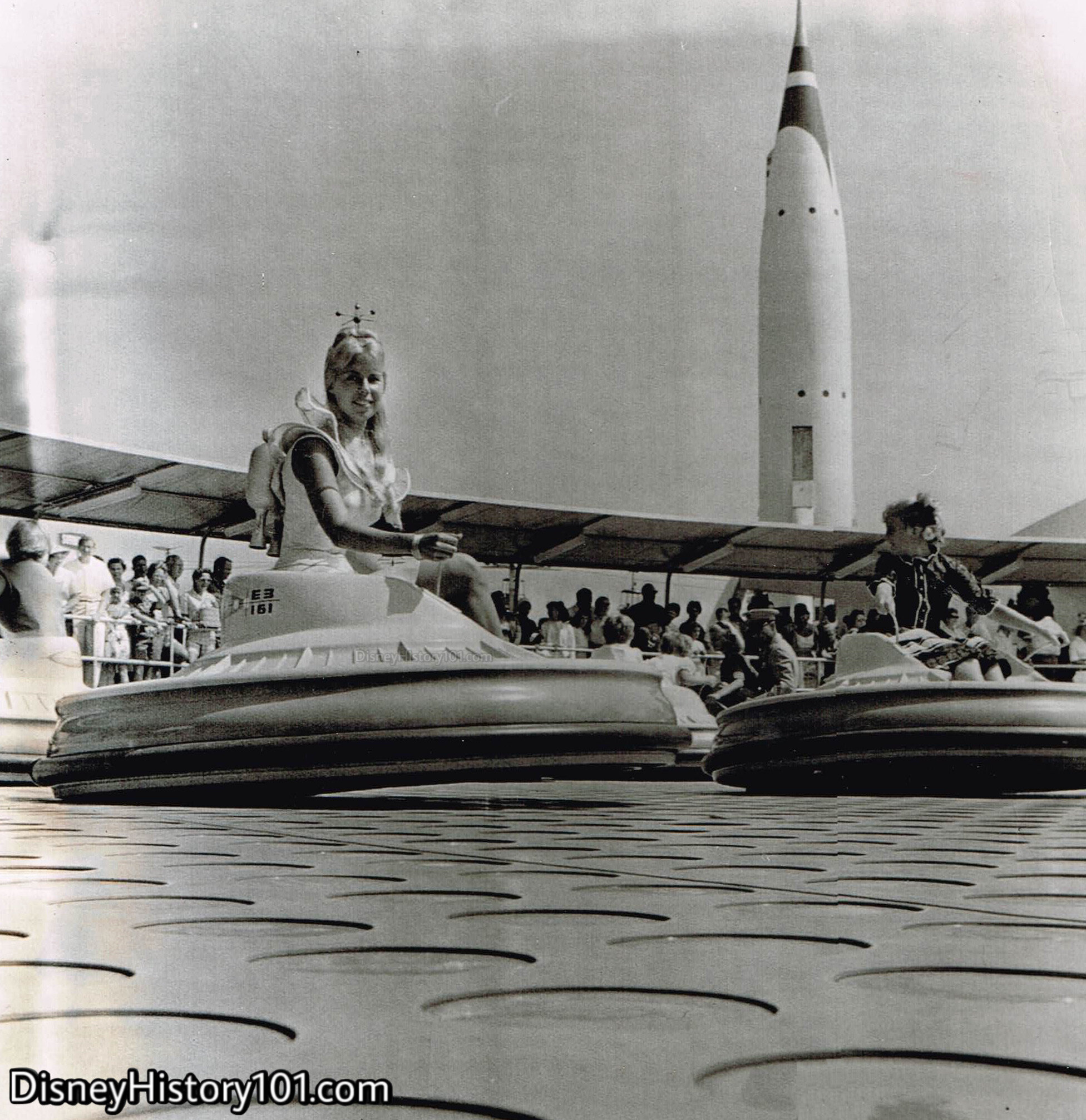
Donn Fox extends a courteous smile as she pilots a Flying Saucer at “the Happiest Place on Earth” on August 14, 1961; Photo Credit UPI Telephoto, Collection of Disney History 101.
In addition to press releases, some magazines (like Amusement Business) spotlighted Disneyland’s newest adventure in the columns of their periodicals.
In advance of the opening, The Disneylander contributor Joe Fowler commented: “A brand new 1961 attraction that will begin to operate soon is the Disneyland Flying Saucer adventure. Just what the impact of this ride will be on our guests imaginations is anyone's guess, and we'll have to wait a few more weeks to know the full story. We feel, however, that we may have another Matterhorn Bobsled on our hands when it comes to queue lines.”
For immediate press release, the preceding image of Space Girl gaining a little altitude, accompanied the following caption in numerous news journals :
“‘Space Girl’ Donna Fox (left foreground) takes to the air in Disneyland’s newest - Flying Saucers. The single passenger ride is motivated by air blasts coming from the many circles on the floor. Passengers weight directs craft in the direction of lean combined with control handles which cause spin. The Disneyland Space Station had its opening 8/14.” It was not unusual to see the Disneyland Cast of Characters riding aboard Flying Saucers. Do you remember seeing Vesey Walker directing from the Disneyland Spaceport, while the Disneyland Marching Band performed sets while riding aboard Flying Saucers?
Many notable Disneylanders supported the Flying Saucers stage at the Disneyland Show, including “55er” Homer Holland and Ron Hemminger (c.1966).

Brand-new Flying Saucers with logos and designations on the backs of the seats, at the Disneyland Spaceport

Amusement Business, Published August 21, 1961
By the October of 1962, the Flying Saucers was operating with all 64 Flying Saucers, exclusively during weekends. This was common during winter operating schedules.
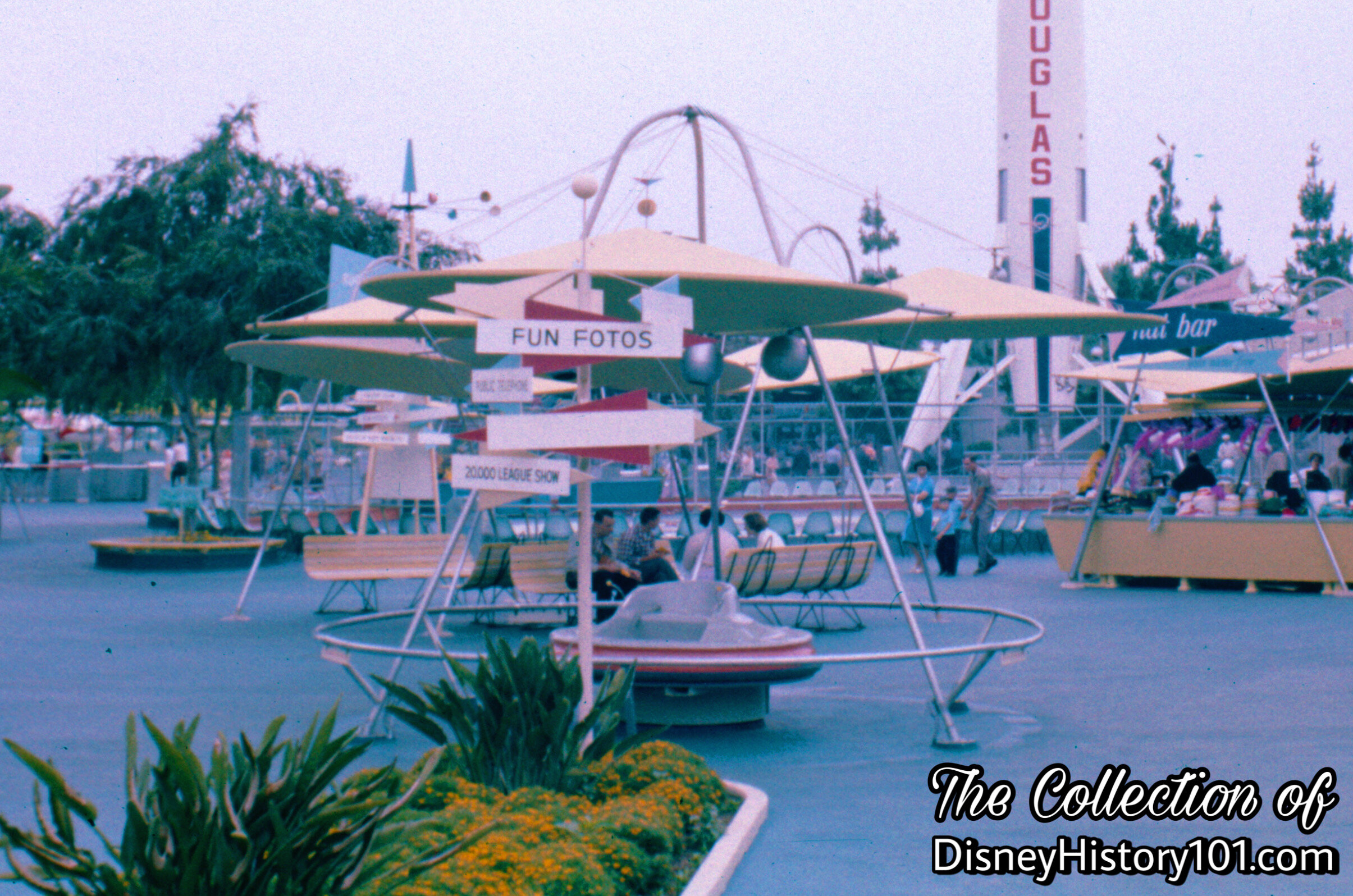
Flying Saucer Exhibit
Similar in style to the “Walt Disney’s Autopia Car Exhibit” Free Exhibit, one of the Flying Saucer vehicles was put on display for guests’ viewing pleasure, or a “Fun Foto” opportunity!
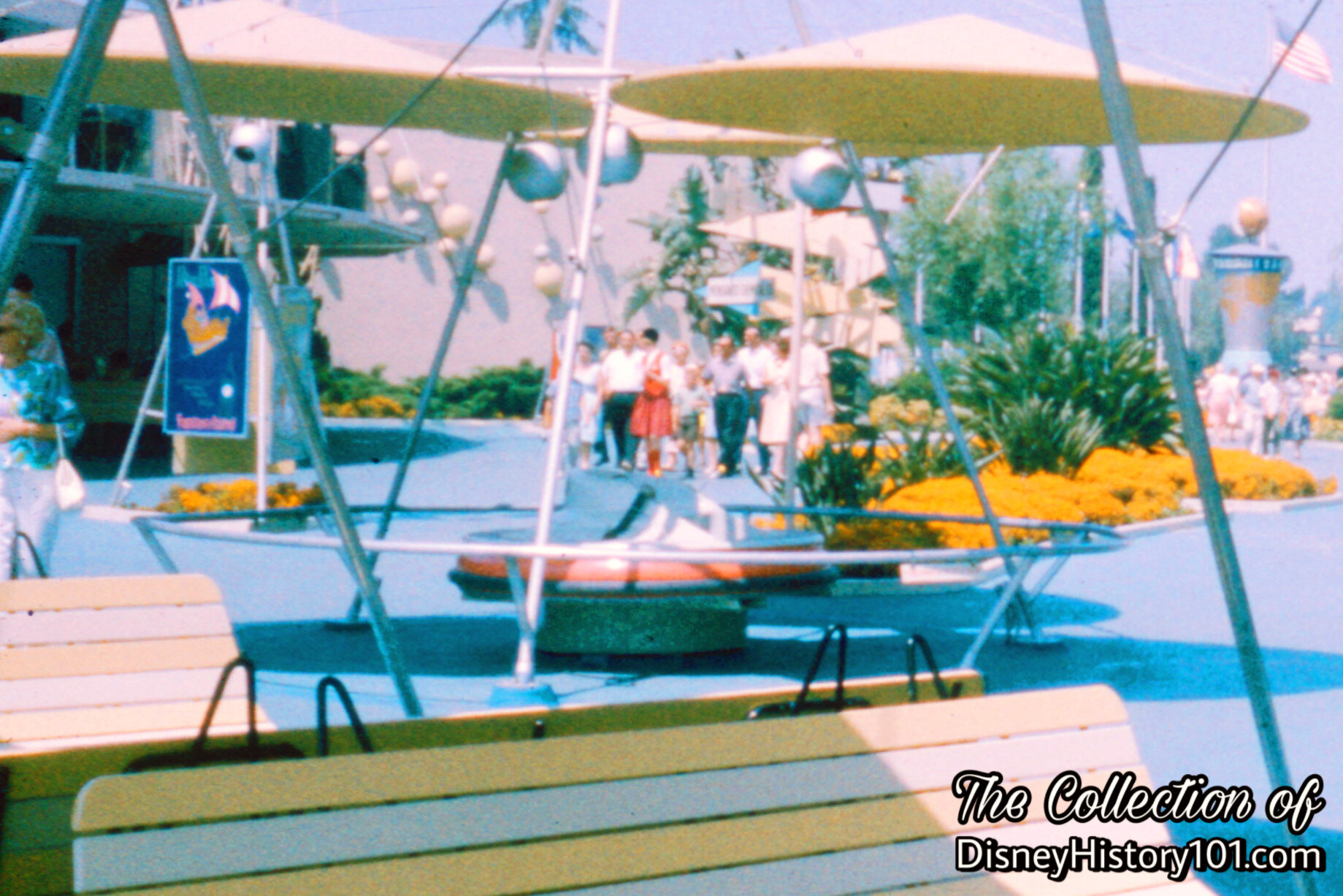
Flying Saucer Exhibit

Flying Saucers, (April, 1963)

One of those air-cushioned, bumper car-style Flying Saucers, (April, 1963)

Flying Saucers at the Disneyland Spaceport, (c. 1962 - 1963)
During an era when the Douglas Moonliner I would begin to tower over the Tomorrowland Skyline, the Flying Saucers would dominate the terrestrial area of Tomorrowland!

Flying Saucers at the Disneyland Spaceport, (December, 1964)
Ride along with family.

By January 1, 1964, the Flying Saucers was a Disneyland "E" Coupon attraction valued at 50¢.
While listed in the Coupon Book as a “E,” the Flying Saucers was closed weekdays during the winter season of 1962-1963, operating only on weekends.
In 1965, the cost of admission for piloting your very own Flying Saucer to thrills and fun was exactly one “D” coupon, or 60¢ - the same fare required to charter a bobsled down the icy slopes of the Matterhorn, or to board a Mine Train for an excursion through the magnificent Rainbow Caverns!
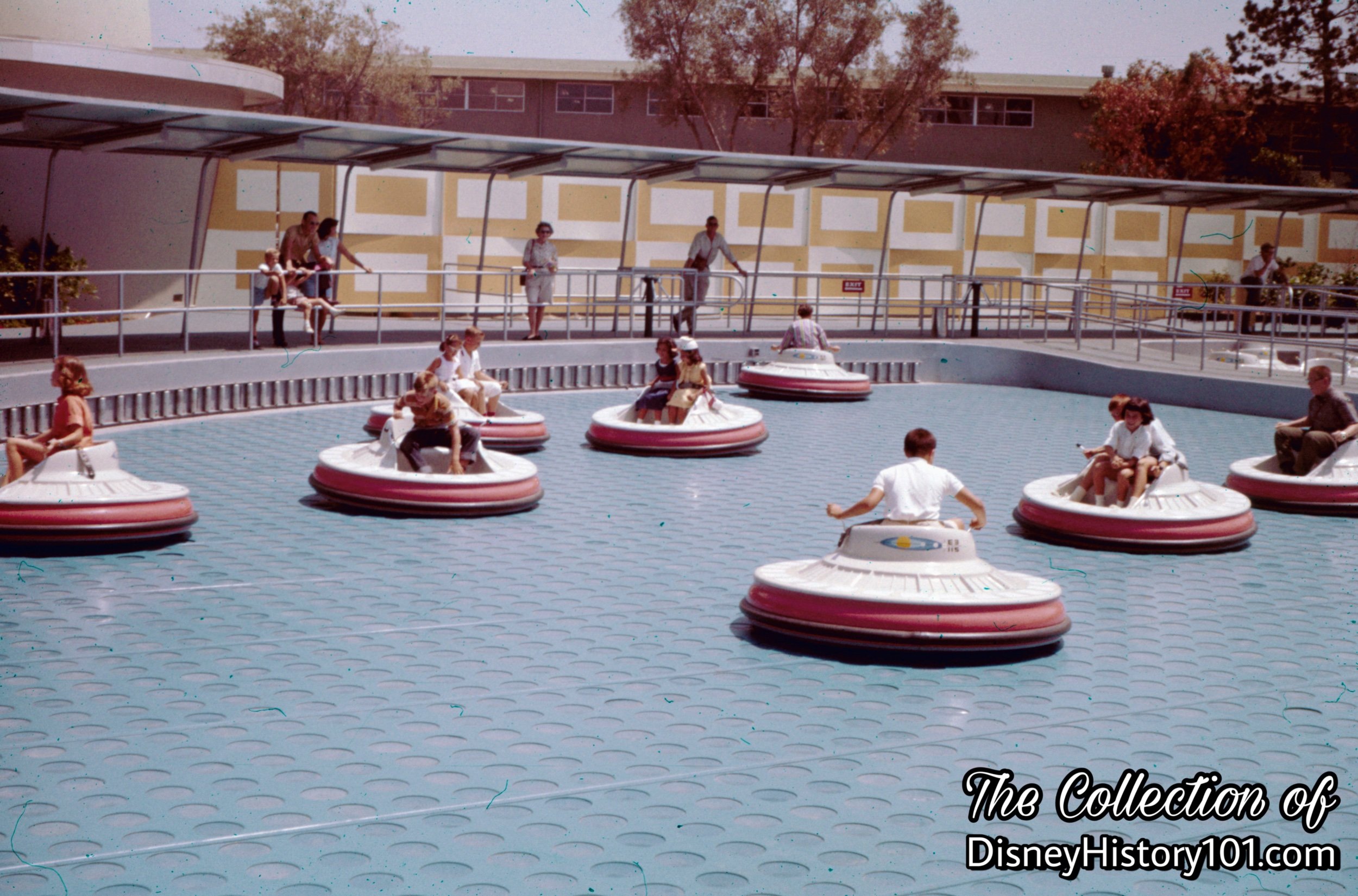
Flying Saucers at the Disneyland Spaceport
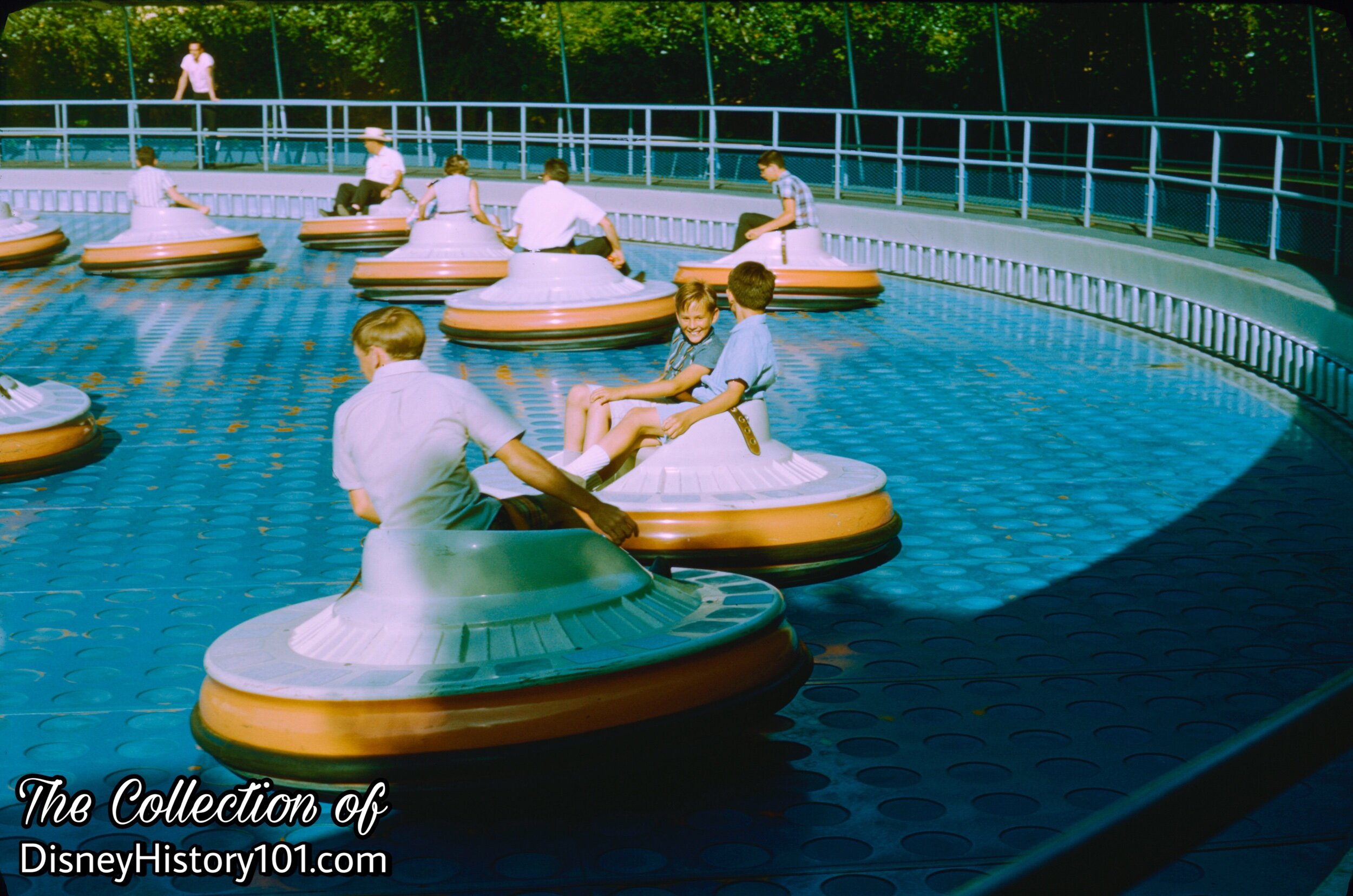
Flying Saucers at the Disneyland Spaceport, (July, 1966)
Ride along with a friend!

Flying Saucers at the Disneyland Spaceport, (1966)

Flying Saucers at the Disneyland Spaceport and Guest Control queue area, August, 1966.
Hover over Tomorrowland-scape on your own!

Flying Saucers at the Disneyland Spaceport

Flying Saucers at the Disneyland Spaceport
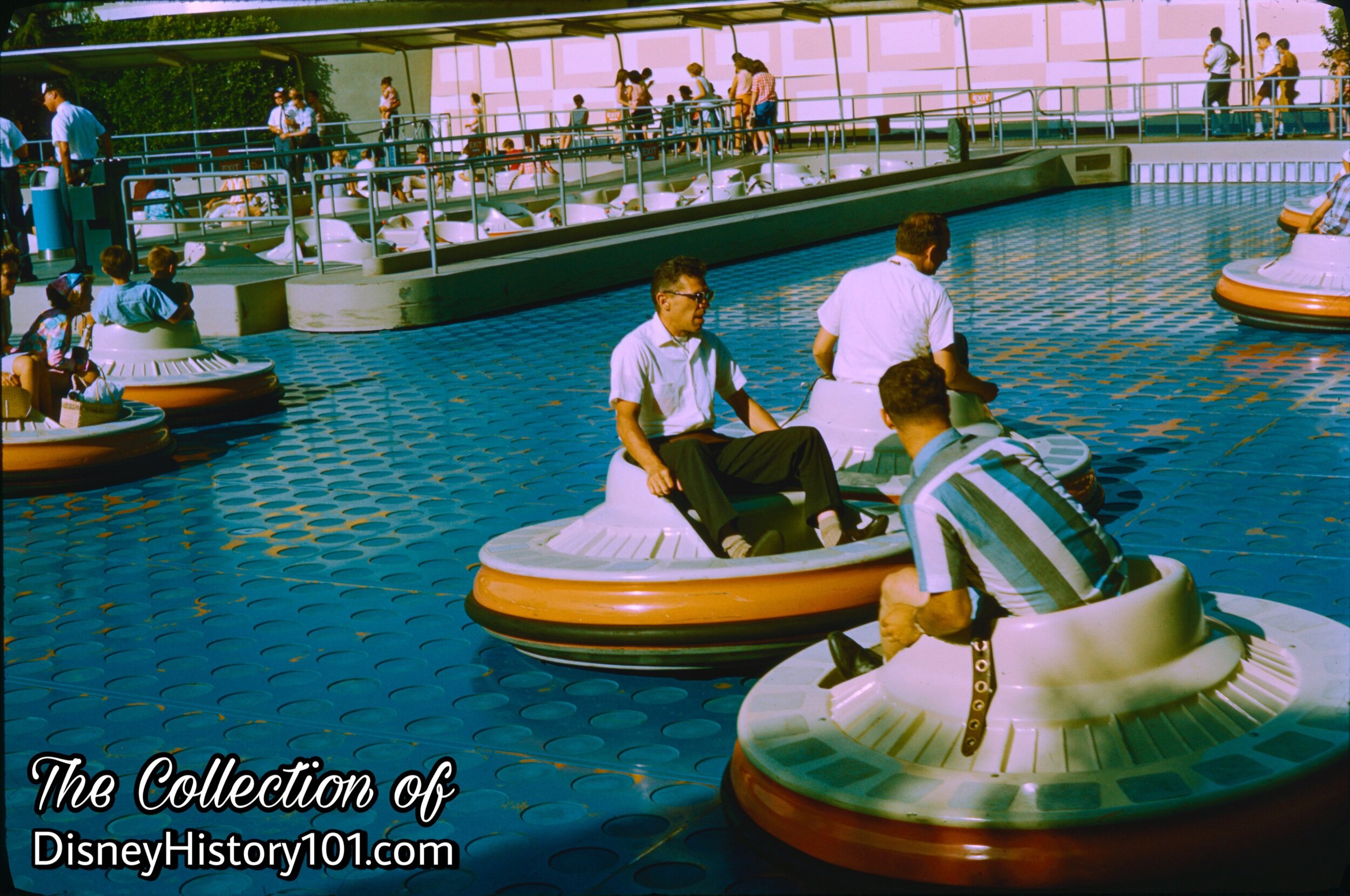
Flying Saucers at the Disneyland Spaceport, (July, 1966)
Apparently, the Flying Saucers were fun for kids of all ages! (Fun Fact - According to Disneyland Holiday magazine, Winter 1957 - 1958 : “among visitors to Disneyland adults outnumber children 3 1/2 to 1.”) This accounts for all the adult Flying Saucer pilots pictured!
Notice the loading area in the background of the previous photos. Guests never need set a foot onto the blue textured area. When the ride time transpired, a mechanical “boom” would sweep across the field. This would corral the fourteen Flying Saucers into the Loading Area, while releasing another set of fourteen Flying Saucers for a few minutes of fun!

Flying Saucers at the Disneyland Spaceport

Flying Saucers at the Disneyland Spaceport

Flying Saucers at the Disneyland Spaceport

Flying Saucers at the Disneyland Spaceport

Flying Saucers at the Disneyland Spaceport
Though enjoyable, the Flying Saucers required a great deal of maintenance, especially on hot days. But for a moment, let’s take another look at these most memorable (and positively “identifiable”) “flying” objects, during a time when Flying Saucer sightings were a daily occurrence in Tomorrowland!

Flying Saucers at the Disneyland Spaceport

Flying Saucers at the Disneyland Spaceport, (1964)

Flying Saucers at the Disneyland Spaceport, (July, 1966)
Guests chose "flight patterns" by shifting their weight.
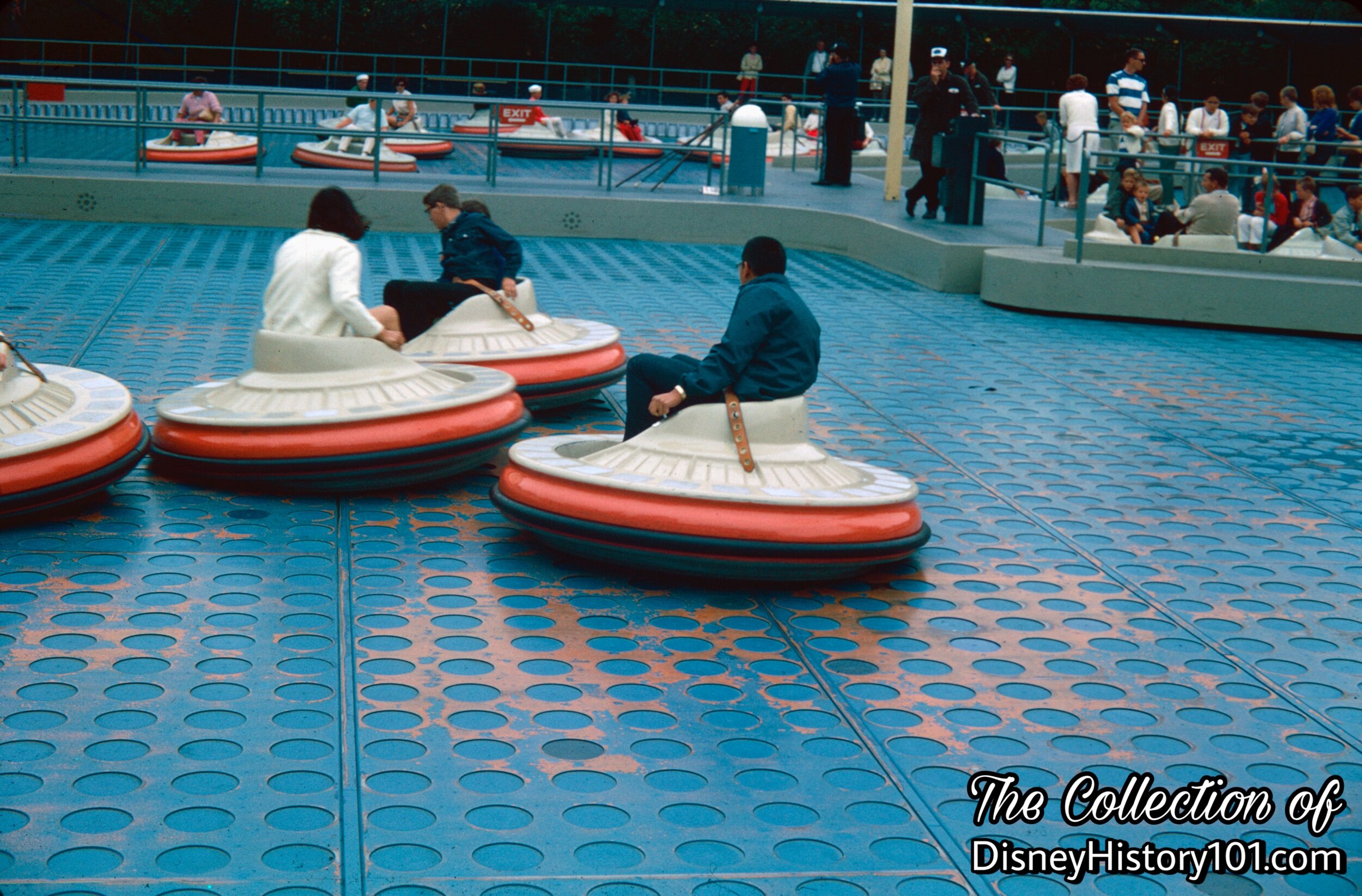
Flying Saucers at the Disneyland Spaceport

Flying Saucers, (July, 1966)
…and that’s something to cheer for!

Media (above) depicted the Flying Saucers while another page teased: “Walt Disney and his ‘imagineers’ at WED Enterprises - the team that created Disneyland and four major shows at the New York World's Fair--are now at work on the boldest, most ambitious of future developments: design of a New Tomorrowland. To research ideas for this exciting project (scheduled to open in Summer, 1967) Walt and his creative staff visited Houston, Huntsville and Cape Kennedy, discussing the latest Space Age wonders with America's astronauts and scientists -including Dr. Werner Von Braun. In New Tomorrowland, guests will experience the sensation of racing through distant space. A towering structure will serve as spaceport and theme center. And a unique new ‘People Mover,’ the WEDway, will carry guests on a scenic tour - even weaving in and out of new exhibits by some of the foremost companies in American industry.”
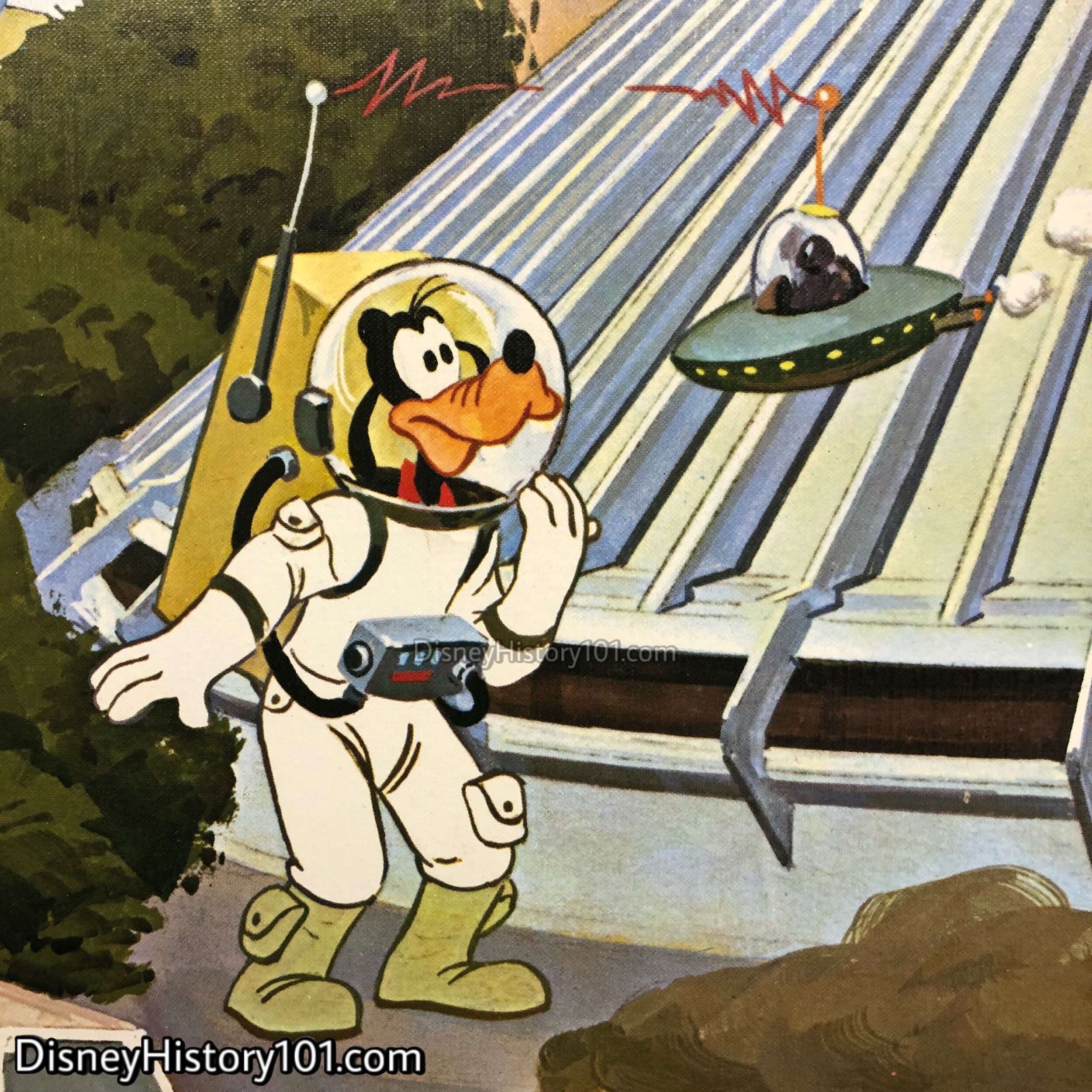
“MURAL EXCERPT”, late 1970s
A contemporaneous mural depicts Goofy (in a spacesuit), near the site of the “Rocket Flight Attraction” building (also referred to as “Space Voyage” in early documentation). Goofy appears to be puzzled by the presence of an unidentified flying object before him.

“Walt Disney’s Guide to Disneyland” Map Excerpt, c. 1968 - 1972
“THE UNIDENTIFIED FLYING ROCKET ATTRACTION”
Internal materials printed in 1966 revealed that “Immediately following Labor Day this year, the Flying Saucers will be taken out and then relocated later under the new space attraction… Space Ride - A new thrill adventure similar in principle to our Matterhorn Bobsleds, where guests will soar through space and around and through a mountain some 200 feet in height.”
Though a “Rocket Flight Attraction” was planned to open during the early 1960s, the Flying Saucers were still detailed on souvenir maps (See Map Excerpt, Late 1960s). Disneyland Plot Plans produced during this era depicted the path of a future Wedway through the area of the Flying Saucers’ Loading Zone, indicating a potential future for the attraction.

Flying Saucers & “WEDway” detailed on a Disneyland Plot Plan, c.1965-1966.

Flying Saucers & “Future Space Mountain” detailed on a Disneyland Plot Plan, c.1966.
“CLOSURE”
Walt once divulged, “When we consider a new project, we really study it. And when we go into that new project, we believe in it all the way.” [“Walt Disney Productions Annual Report to Shareholders and Employees Fiscal Year Ended October 2, 1965”]
All together, the interactive Flying Saucers operated a good half-decade - from 1961 to 1966. According to the Walt Disney Archives, “more than 5 million guests took flight in Disneyland’s Flying Saucers - that’s almost 1 million guests per year.” In fact, the exact total of guests aboard the Flying Saucers was 5,313,882 (according to a study taken in 1971).
Years later, a “Rocket Flight Attraction” (which would allow guests to soar in a different type of vehicle), and a new entertainment venue called the Tomorrowland Stage (adjacent to the soon-to-be Space Mountain Amphitheater) opened in its place. That particular “Rocket Flight Attraction” would “land” inside Space Mountain on May 27, 1977. By this time, the Flying Saucers had long since vanished (on September 5th, 1966) in favor of the upcoming “New Tomorrowland” project!
The Flying Saucers was once considered a “future project” for Tomorrowland at The Magic Kingdom. The Flying Saucers did have a legacy (of sorts), as their aesthetically appealing design would even go on to influence the shape of the enormous structure that housed Space Mountain!

Flying Saucers and their extra-terrestrial pilots appear alongside concepts for Bear Country; Marc Davis 1970s.
Flying Saucers and alien encounters nearly had a legacy in tableaux envisioned by Marc Davis, for the Disneyland Railroad and in an original experience planned for the Tomorrowland PeopleMover.

Flying Saucers (“…of Walt’s imagination”) have been spotted at the Walt Disney Family Museum.
The Flying Saucers lived on through occasional exhibit displays (like the Walt Disney Family Museum; pictured above) and exclusive & limited-edition merchandise (pictured below).
Far in the future (by 2008), the name would live on with a shop known to Disneyland Cast Members and Guests as “Flying Saucers Hats”.

Guests could bring home a “Flyin-Saucer,” a gyroscopic airfoil inspired by Tomorrowland at Disneyland; originally priced at $.61.
Tomorrowland Flyin-Saucers were available in red, blue, yellow, and orange, retailing at .59¢ each. The toy was “engineered and made of unbreakable plastic” to fly “straight, curves, circles, skips.”

A Flying Saucer “Disneyland Classics” Cast Member exclusive pin, released in 1995.

A Flying Saucers model prototype mock-up.
This model was once offered exclusively through the Disneyana Shop in honor of New Tomorrowland expansion of 1998.
